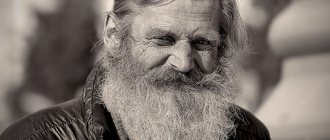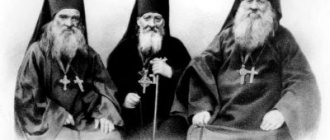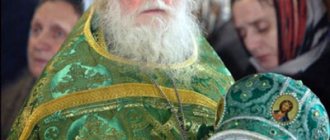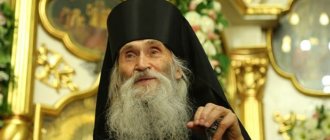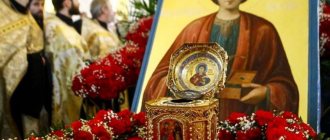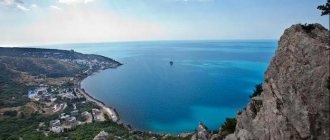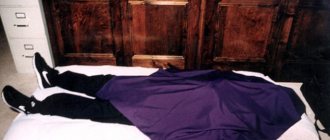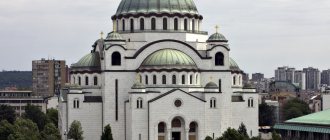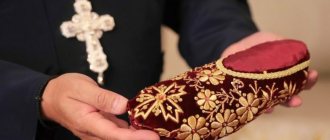Elders occupy a special place in Orthodoxy. These are, as a rule, clergy, monks, whom the Lord himself chose to guide sinners on the true path, give valuable advice, share wisdom, heal from various diseases and help people in need.
Since ancient times, legends have been made about them. People believed that they were able to perform miracles, see and communicate with the Lord himself. Are there any elders living in our time, now, in 2019?
Elders occupy a special place in Orthodoxy
Brief lives of some elders
Unfortunately, some elders have already left our world. Priest Naum, who worked in the Sergius Trinity Lavra (Sergiev Posad, Moscow region) and Kirill Pavlov, a father serving in the Kaluga region, in the Borovsky monastery. They were also known for their visionary abilities, kind deeds and love for people.
Priest Nahum
It is worth noting that in our time you can meet people who call themselves “young old people.” These, unfortunately, are pure deceivers, in no way connected with the clergy and the Orthodox Church.
You can meet many young and inexperienced priests who allow themselves to be called the chosen elders. This is also pure quackery. Some of them even create sects in which nothing but perversion, intimidation, destruction of the psyche and money extraction occurs.
New in blogs
Currently, the “spiritual brother” of Nikolai Guryanov, mitred Archpriest Ioann Mironov, serves in St. Petersburg, the rector of the church in honor of the Icon of the Mother of God “Inexhaustible Chalice” on the territory of the ATI plant.
In Pskov, the elder Father Hermogenes (Murtazov) serves in the Snetogorsk monastery.
In Zayanya, in the Nikolskaya monastery, the “spiritual child” of Nikolai Guryanov, the perspicacious Father Roman (Zagrebnev), serves as abbot. He, like Nikolai Guryanov before, is in the position of being persecuted by the authorities for his frank prophecies. However, if you manage to meet him, you will probably be able to talk to him in private.
Archimandrite Kirill (Pavlov) (b. 1919) fraternal confessor of the Holy Trinity Sergius Lavra, confessor of Patriarchs Pimen and Alexy II
Archimandrite Naum - Trinity Lavra of St. Sergius, Sergiev Posad. Accepts daily except Sunday.
Father German (Chesnokov) - Trinity Lavra of St. Sergius, Sergiev Posad. He is engaged in reprimanding demons. Possesses the gift of foresight.
Father Vlasiy, the visionary - Kaluga region, Borovsk, Pafnutev-Borovsky monastery. Confesses from time to time. It's better to come for a few days.
Father Peter, visionary, confessor - Lukino, Nizhny Novgorod region. It's better to come for a few days.
Archimandrite Dionysius - Moscow, Church of St. Nicholas the Wonderworker in Pokrovskoye (Bakuninskaya, 100). He has the rare power of prayer and the gift of shepherding.
Father Schema-Archimandrite Iliy - Now lives in Peredelkino, being the confessor of Patriarch Kirill, he hardly receives anyone.
Father Jerome - Alatyr, Chuvashia, Assumption Monastery.
Father Hilarion - Klyuchevskaya Pustyn, Mordovia, village. Turgenevo. Getting to confession is relatively easy.
Archimandrite Ambrose (Yurasov) - Ivanovo, Holy Vvedensky Convent.
Schema-Archimandrite John - Ioannovsky Monastery near Saransk. Gives a lecture.
Father Nikolai is the rector of the Intercession-Ennat Monastery in Bashkiria.
Archimandrite Adrian (Kirsanov) - Pskov-Pechersky Monastery, Pskov region. Almost does not accept... Archpriest Valerian (Krechetov) - Church of the Intercession, p. Akulovo, Odintsovo district. Confessor of many Moscow clergy. Bishop Alypiy - Ukraine, Donetsk region, Krasny Liman. Father Seraphim - Ukraine, Donetsk region, Svyatogorsk, Svyatogorsk Lavra Archimandrite Mitrofan, Zhirovitsky Lavra, Belarus (Slonim, Grodno region). Almost doesn't accept it. We need to come for a few days. There are several insightful monks in the Pochaev Lavra in Western Ukraine (Pochaev, Ternopil region). There it is not difficult to talk with the elders without making an appointment or waiting.
Bishop Thomas: “The seeds of the elders’ instructions will sprout if the heart burns with love for God”
In 2021, the Holy Trinity Lavra of St. Sergius celebrates the 75th anniversary of the resumption of divine services. The Lavra's abbot, Bishop Thomas of Sergiev Posad and Dmitrov, answers questions from the Monastic Bulletin portal.
Vladyka, the revival of the Trinity-Sergius Lavra began immediately after the Great Patriotic War, about which there are memories of people who witnessed that truly amazing phenomenon, a real miracle that took place during the Soviet years in front of the eyes of what was then a huge country. Which of those memories, which facts described (or heard from someone) stuck in your memory, in the memory of many of the brethren, and continue to evoke warm feelings today?
First of all, I consider it a real miracle that, despite all the hostility and intolerance of the Soviet government towards the Church and its shrines, by 1946 we had preserved the relics of St. Sergius. The Lavra was closed for 26 years. A quarter of a century of spiritual desolation and ugliness... The throwing down of crosses and bells, public baths and canteens instead of churches, the expulsion of the inhabitants, the execution of the brethren at the Butovo training ground... Terrible years! And it is amazing that the relics of the Reverend survived.
Now, of course, many come from remote areas of our country to see the ancient churches of the Lavra, to become familiar with history, to be imbued with the spirit of the Trinity Cathedral, but the greatest treasure has always been and will remain the relics of the Venerable. He is our abbot. Hegumen of the Russian Land. And we are his children. And after each fraternal prayer service, the inhabitants of the monastery clearly feel this paternal care and concern.
More on the question of memories. While asceticizing in the Lavra, you probably found the Lavra elders who opened the world of monasticism to many young people and spiritually nourished them. At this stage, what do you, as the abbot of the monastery, want to do so that not only the memory of those great elders is alive, but also their instructions, examples of their sacrificial service help the monastics of the present time to grow spiritually, as those generations grew?
Let me start by saying that personal holiness cannot be taught. It cannot be taught as a lesson, it cannot be passed on as a thing. It must be achieved independently throughout life. Of course, the saints who shone in the land of Radonezh, and our famous elders, showed the path, following which it is possible to quickly approach monastic perfection.
St. Sergius - “the rule of faith and the image of meekness”
, as it is said in the akathist. The Monk Nikon set an example of obedience. And the Monk Micah, out of the purity of his heart, was honored to witness the appearance of the Most Pure Theotokos. The Russian land knows a whole host of disciples of St. Sergius, who shone with a variety of virtues and achieved holiness. You wonder: why? Is it because they were honored to live with the saints? But, rather, because they set the Kingdom of Heaven as their main, desired goal.
Unfortunately, no amount of instruction will help a brother if his heart does not burn with love for God. This is the main secret of the saints and elders. To be like them, you must also love God “with all your heart and with all your soul and with all your mind.”
(Matt. 22:37). It is important to understand that the only Giver and Source of true virtue is the Lord Himself. Only then will the instructions of the elders become effective when the soil of our heart is fertilized and suitable for cultivating virtue. Therefore, as the abbot of the monastery, I always first of all want to encourage new monks to strive with all their souls towards God and cultivate the soil of their hearts. And then the seeds of the elders’ instructions will sprout with renewed vigor.
Vladyka, how many brethren labor in the Trinity-Sergius Lavra? Do young people come here now who have seen that the monastic path is their path?
Today the number of inhabitants of the Lavra, including all the monasteries and farmsteads, is about 300 people. Of course, young people enter the monastery. In particular, some of them come from among students or graduates of the Moscow Theological Academy. During this Lent in the Lavra, three novices took monastic vows and four took monastic vows.
Your Eminence, having become the governor of the Lavra not very long ago, have you already felt that the Spiritual Council of the Lavra is a support for the leader of the monastery? How does his help manifest itself?
Of course, the Spiritual Council is support and support for the governor. The Lavra elders and experienced monks who are part of it help to understand difficult situations, both disciplinary and administrative, give advice, and help make decisions. The power and importance of this support is very tangible.
Hermitages and metochions - what do they mean for the Lavra, for the monastics and for you as the governor? What is their purpose, what problems are solved there?
The Lavra, with its monasteries and farmsteads, covers and solves many problems - both spiritual and practical. First of all, monastics have the opportunity to get away from the bustle and focus on prayer and spiritual achievement. In some monasteries, services are performed according to special, more strict rules. For example, not far from Sergiev Posad there is the Sergievsky monastery, where the brethren pray during long night services. In some farmsteads, vegetable gardening is developed - the monks work on the land. Some are located in places significant for the history of the Lavra. Like, for example, the Varnitsky courtyard in the city of Rostov the Great - the place where the Monk Sergius of Radonezh was born. Moreover, now there is the Varnitsa Men's Gymnasium, after graduating from which many graduates enter the Moscow Theological Academy. Or, for example, the Gremyachiy Klyuch courtyard. It is located at the source found by St. Sergius. At the same time, it is very good that such significant places are accessible to pilgrims; church life goes on there.
It is impossible for us to imagine the Lavra without pilgrims and tourists who come here from different parts of the world. You can understand them! Visit the spiritual heart of Russia - the largest center of Orthodoxy, venerate the shrine with the relics of St. Sergius! For a believer this is great happiness. But for the brethren, silence and a calm monastic life are important. Is it possible to somehow solve this problem - to protect the monastics from the inevitable noise with such a flow of pilgrims, or does this remain an acute problem?
Yes, indeed, the flow of people to the Lavra is not diminishing. Every year, the Trinity-Sergius Lavra is visited by about 1.5 million tourists and pilgrims. Of course, last year, when the whole world was paralyzed by the pandemic, significantly fewer people began to come. The monastery observed restrictions and was closed for some time. Now the pilgrimage has resumed, but not on the same scale. We really hope that by the grace of God everything will soon stabilize, the pandemic will be behind us and everyone will be able to come again to the monastery of the Abbot of the Russian Land.
From its very foundation by St. Sergius, the Lavra was not a closed monastery. From the life of the Reverend we know that both simple peasants and great princes repeatedly turned to him for prayerful help. And he did not refuse anyone and did not hide from anyone. He truly was the light of the world and the salt of the earth. And it is our duty, as far as possible, to preserve his covenants: to receive the wandering, to console the mourning, to help the unfortunate, to give spiritual advice.
Of course, in order to protect the brethren from unnecessary worries and vanity, many obediences and works, where appropriate, are performed in the monastery by lay people. For example, they work as tour guides at the Pilgrimage Center, volunteers of the Social Service, employees of the press service, the Cellar Service, and so on.
What can you say in general about the pilgrimage to the Lavra? Can you compare the pilgrims of the time when you came here in your youth, entered the theological seminary, and were later enrolled among the brethren - and today's pilgrims? Are they different in any way?
Both then and now, people bring their sorrows and joys to the Reverend, pin their hopes on his help and express gratitude for the mercies shown. However, now not only pilgrims come to the Lavra, but also a large number of tourists, including from abroad. On the one hand, this is good: after all, being in such a holy place, a sleeping soul can finally wake up, Divine grace will touch the heart, and a person will leave differently, transformed. There is a share of preaching and missionary work in this. But, unfortunately, there are those who see in the architectural ensemble of the Lavra only a historical and tourist site. And this cannot but sadden.
Vladyka, tell me, how is it planned to celebrate the 75th anniversary of the revival of the Trinity-Sergius Lavra?
We celebrate this significant date with divine services, a prayer of gratitude to the Lord and St. Sergius of Radonezh for the preservation of the monastery, shrines and, of course, for the opportunity for us all to stay here. Also timed to coincide with this event was the Great Consecration of the Assumption Cathedral, in which, with the blessing of His Holiness Patriarch Kirill of Moscow and All Rus', a new white stone Throne was installed. The consecration took place on May 5.
Source:
Monastic Bulletin
The spiritual connection with the elders is not lost
The Sochi diocese is one of the newly formed. At the end of 2018, it was separated from the Ekaterinodar and Kuban diocese and included in the Kuban Metropolis. Two existing monasteries - the Krestovaya Pustyn monastery in the village of Solokhaul and the Trinity-George Convent in the village of Lesnoye - are developing and becoming a spiritual outpost in this region. What kind of difficulties arise for monks and what helps them overcome them - this became one of the main topics of conversation with the rector of the monastery “Krestovaya Hermitage”, Abbot Lev (Rodent), who is responsible for the diocesan monasteries in the Sochi diocese.
The leadership of the monastery is in the hands of the Mother of God
Father, need I say that many people associate the city of Sochi and its surroundings primarily with the sun, sea, picturesque nature and resorts? And in spiritual terms, what can you say about the region where the Lord destined you to labor?
Spiritually, our region is complex. Next door is Abkhazia, where the situation of Orthodoxy today, as we know, is difficult. On the other side of us is the Republic of Adygea, where many Muslims live. And in Sochi, one might say, there is a mixture of nations. According to official statistics, there are more than 100 nationalities here - Russians, Ukrainians, Armenians, Georgians, Greeks, Circassians (or Circassians), etc. This creates a peculiar flavor, but I would like to note that the majority of representatives of different nationalities treat faith with respect and kindness. We appreciate this and recognize how strong our prayers must be if the tradition of peaceful coexistence is to continue to be strengthened.
Father, how long have you been in this monastery and how did you accept your abbess?
In the summer of 2012, Metropolitan Isidor of Ekaterinodar and Kuban sent three brethren (including me) from the Holy Spirit Monastery in the city of Timashevsk to the “Krestovaya Hermitage” monastery. Things were somewhat neglected here - both in spiritual life and in economic life. The monastery had no documents, no land, and spiritual life was not organized in it. The former abbot mainly dealt with people who suffered from drunkenness or drug addiction, but the monastic spirit as such was not felt in the monastery. At that time, about 30 people lived in it, but they were different people, not monastics. Some of them left immediately after our arrival, others within the next year and a half.
Now the brethren are small - about 12 people. However, the Lord said: “Do not be afraid, little flock!” (Luke 12:32). Indeed, it is better to have a few people of the same spirit than a multitude of people gathered together for no clear purpose. When a person has a different spirit, this will sooner or later be revealed, since the leadership of the monastery is in the hands of the Mother of God. We have a miraculous icon of the Most Holy Theotokos “Three Hands” from the Serbian monastery on Mount Athos, where there has long been a tradition that the abbot there is a figurehead, and the Abbess is the Mother of God. We adhere to the same tradition. I am, as it were, nominally, legally the head of the monastery, but everything here is controlled by the Mother of God. And if a person is overcome by some passions that he hides from others, then sooner or later they come out. After all, as sometimes happens: someone is looking for some special prayers, special states, special insights, something else, not wanting to understand that there are certain stages of spiritual growth. In other words, if you do not rise up the “steps” of virtues, as St. John Climacus and other holy fathers wrote about, then you cannot expect any success in spiritual life. Anyone who comes to the monastery is ready to express love for God through deeds - he shows sacrifice, courage and humility - which means he will certainly remain in our monastery. If you’re not ready, you’ll leave...
At one time, I didn’t want to leave the large and spiritually organized Timashevsky Monastery, where the number of brethren reached 100 people. For almost 20 years, the monastery developed under the spiritual leadership of the elder - the governor and founder of the monastery, Archimandrite George (Sava), to whom you could go to his cell with many questions, but the elder blessed you and that’s it - no more questions! Why aren't there any? Yes, because the spirit of malice with its questions and doubts remained outside the walls of the cell. You came in here alone! It was difficult to leave my native monastery, and I accepted the abbess in another monastery not without internal grumbling. Our faith is weak, we have no faith in God’s Providence - everything comes with age, with experience. But after I visited Athos and heard from the Athos confessors that being an abbess is simply obedience, I calmed down internally and now treat it like other obediences, the fulfillment of which is the main virtue in monastic life.
These elders were a reflection of the glory of Christ
Do memories of the elder, Father George (Sava), help you fulfill such a responsible obedience to the abbot of the monastery?
Not just memories, but a living prayer connection with him! Father George was buried in the monastery courtyard, on the Nekrasovo farmstead in the Timashevsky district, near the Church of the Holy Great Martyr George the Victorious, as he bequeathed. Literally a year after his death, construction began - a chapel was erected and consecrated over the grave. We go to the priest’s grave, serve a memorial service, ask for help and receive this help through his prayers. Yes, of course, we cannot see him, hear his voice, but the spiritual connection is not lost. It is the grace of God that we were lucky enough to meet such a person who was a reflection of the glory of Christ and whom we wanted to emulate in our lives. Otherwise, we would not have endured the labors that we had to endure in the “Cross Hermitage” monastery, if we had not had the foundation laid by the priest. I remember my first meeting with him well. Schema-Archimandrite Blasius from the St. Pafnutev Borovsky Monastery blessed me and my spiritual brother (now the monastery leader Hieromonk Meletius (Popadych)) to stay together and go to the monastery to visit Father George in Kuban. Father George seemed strict to me (he really was strict). But the eyes are like a child’s – pure and mischievous! Being next to him, you couldn’t help but feel the spiritual power emanating from him! I would even say this: he was a man – the granite of the spirit. He had the same spirit as the Venerable Savva the Sanctified, the Venerable Sergius of Radonezh, the Great Martyr George the Victorious - his Heavenly patron. Father, except God, was not afraid of anyone. He boldly defended Orthodoxy - from heretics and sorcerers. And thanks to his active position in this matter, Metropolitan Isidore at one time excommunicated from church communion two “clairvoyant journalists” who published a newspaper and books with occult content.
I remember that at our first meeting, Father George began to tell me things that I did not understand then, but today I realize that Father saw a lot in advance, warned me about many dangers that awaited me. In general, his instructions were brief. Father explained everything simply, relying on the advice and teachings of the holy fathers of the Church, as well as those elders who looked after him in monasteries from the age of 12. In our understanding, an elder is a person endowed with the grace and gifts of the Holy Spirit. What are these gifts? Confession of thoughts, spiritual guidance. The ability to suggest and find a wise way out in some situation. Love for worship and prayer, healing - spiritual and physical, insight and miracles. If monastics or spiritual children from the laity have obedience, the elder can lead such people and lead them into the Kingdom of God. Father George was led into the Kingdom of God by his spiritual mentors, and he took us on his shoulders...
Father Lev, you said that the elders looked after the priest in the monastery almost from childhood. Did he tell the brethren about the time during which his spiritual formation occurred?
He told me. From his stories one could imagine how difficult it was for monastics in Soviet times, especially during the years of Khrushchev’s persecutions. Father George was born in Transcarpathia into a believing family. His teachers were the already glorified Schema-Archimandrite Alexy (Kabalyuk) - the Venerable Alexy of Carpatho-Russia (in Transcarpathia they call him Carpathian, because among today’s nationalists the words “Rus”, “Rusyn” should not be heard) and the abbot of the first monastery where the priest ended up 12 -year-old youth, Archimandrite Job (Kundrya) - Venerable Job of Ugolsky. Also schema-abbess Maria (Rybar) - abbess of the Chumalevsky monastery and her brother - hieroschemamonk Hilarion and others. The apostolic ministry of St. Alexy of Carpatho-Russia, the real leader of the Rusyns, can be compared with the activities of St. Equal-to-the-Apostles Nicholas of Japan in enlightening the Japanese. There is a lot of evidence of this, but the main thing is that Transcarpathia was then in a union, in Catholicism, and today there are dozens of Orthodox churches on this land, many priests have come from this land, and many young people go to study in Orthodox theological educational institutions... The second elder, Archimandrite Job , like Schema-Archimandrite Alexy, received a blessing on Holy Mount Athos, in the Russian Monastery of St. Panteleimon. There he was presented with a particle of the relics of the holy great martyr Demetrius of Thessalonica and sent to his native Transcarpathia to preach the word of God. And he founded a men's monastery with the Athos charter in Gorodilov. It is known that Father Job corresponded with the Monk Silouan (Athos), one of the most revered saints of the 20th century by the Orthodox Church.
I can’t help but name another priest’s teacher – Schema-Archimandrite Bogolep (Cleric). He was not only a wise spiritual mentor, but also a healer of bodily ailments using medicinal herbs. Father Bogolep communicated with Saint Luke (Voino-Yasenetsky), Saint Luke respected him very much. Our father also visited the saint. The elder, Father Bogolep, knew medicinal herbs well and collected them. He had permission from the Red Cross Society to provide medical assistance. Father George learned medical practice from Father Bogolep. A novice youth ran to his monastery, walked with him through the mountains, he showed him different types of herbs and taught him how to make ointments and tinctures. Just the ones we use now. Currently, Father George’s monastery anti-cancer collection of 16 herbs is widely known. In fact, Schema-Archimandrite Bogolep compiled this collection and taught the priest how to treat oncology and other diseases. And then the priest began to teach us. And although I don’t particularly do this now, if a person comes with oncology or something else so serious, I try to help. Of course, we pray for the sick in the monastery - but, in addition to this, we also try to help physically. I make sure to pass on my father’s instructions to everyone: to cleanse the soul through true repentance, without which recovery is impossible.
In the biography of Schema-Archimandrite George, which can be found on Orthodox websites, the following fact attracts attention: the priest was awarded church awards at various times, but the Order of St. Seraphim of Sarov, II degree, as indicated in parentheses, was not awarded to him...
The decree on his awarding this order was signed by His Holiness Patriarch Kirill of Moscow and All Rus' on June 6, 2011. Father was already seriously ill. Ten days before his death, on June 8, 2011, at the request of the priest and with the blessing of Metropolitan Isidore of Ekaterinodar and Kuban, the dean of the Holy Spiritual Monastery, Abbot John (Konovalov), in the presence of the brethren, tonsured our elder to the rank of the great angelic image - the schema with the name George in honor of St. George of Iveron Athos. The schema-monk departed to the Lord on June 18. Before the start, Bishop Isidore, who led the rites of the monastic funeral and burial, announced the decree of Patriarch Kirill on awarding Schema-Archimandrite George with the Order of St. Seraphim of Sarov. The Bishop noted that the deceased himself had said more than once that the reward must be received in Heaven. But this earthly reward, said the archpastor, is one of the testimonies of those labors, sorrows, exploits and worries that Father George bore on earth according to the commandment of God - for the sake of his neighbors. His Eminence handed over the order for safekeeping to Abbot Ioann (Konovalov), who became the priest’s successor. All these years after the death of the elder, Archimandrite John has been obedient to the abbot of the monastery. By the way, his memories of the priest, as well as the memories of Metropolitan Isidore, Archbishop Pitirim of Syktyvkar and Komi-Zyryansk, Bishop Herman of Sochi and Tuapse, my memories and the stories of other people who knew Father George closely can be heard by watching the film “They Don’t Descend from the Cross” . It was created through the efforts of the Society of Zealots of the Memory of Metropolitan John (Snychev) together with the Holy Spiritual Timashevsky Monastery with the blessing of Bishop Isidore. The presentation of the film took place last fall in St. Petersburg and a little later - in the Nikolo-Berlyukovskaya men's desert near Moscow. There is a film on YouTube, where two episodes are presented: “They don’t come down from the cross. Ascetic”, “They don’t come down from the cross. Confessor".
Through prayers the Lord arranges everything, and all issues are resolved
Father, now let’s return to the monasteries of the Sochi diocese. There are also a lot of videos dedicated to them on YouTube. You look and admire the beauty of the places in the foothills of the Caucasus and the beauty of the temples and monastic buildings erected in these monasteries in our time. But let me quote Archimandrite John (Krestyankin), who warned the young monastic brotherhood in one of his letters: “Wouldn’t all our energy go into the vanity of external arrangement. And how difficult it is to acquire basic spiritual skills in obedience, prayer, and patience. These things done on the run and at a gallop do not take root.” From your story it became clear that the situation in the monastery has changed. What is the situation in the convent?
Until recently it was not easy. After all, the leader of a monastery must be an ascetic who sets an example for his brothers or sisters. At the end of last year, at its last meeting, the Holy Synod of the Russian Orthodox Church adopted a resolution to appoint nun Drosida (Sorokopud) as abbess of the monastery. On December 28, 2021, our ruling bishop, Bishop German of Sochi and Tuapse, celebrated the Divine Liturgy in this monastery and at the Small Entrance elevated nun Drosida to the rank of abbess, placing a pectoral cross on her and presenting her with the abbot’s staff. Vladyka Herman warmly called her a turtle dove that flew from the nest of the convent of St. Mary Magdalene Equal to the Apostles in the village of Rogovskaya, Timashevsky district, Krasnodar region. This monastery is also closely connected with the name of our elder, Schema-Archimandrite George. Under his leadership, a temple was built there and a subsidiary farm was organized. Until the last days of his earthly life, the priest looked after the sisters, being the confessor of the monastery. And in the convent of the village of Lesnoye, Adler district, after the appointment of a new abbess, monastic life began to adjust. And now, thank God, services are held constantly.
At our monastery “Krestovaya Hermitage”, with the blessing of Bishop Herman of Sochi and Tuapse, a women’s monastic skete of the Icon of the Mother of God “Quick to Hear” appeared - a hesychastirium where several sisters constantly work in prayer. Feeling the great power of prayer, we understand that we need to pray fervently so that the Lord Himself will arrange everything. And we clearly see: if there is God’s providence for this or that matter, there is God’s blessing and the intercession of the Mother of God, the Patroness of all monastics, then everything will work out. For example, we had problems with land documents that seemed insoluble. In 2021, with the help of God, we resolved them. Although land in Sochi is very expensive, the monastery now has about a hectare in its use. Without prayer, we would not have any land. We ourselves prayed and asked for the holy prayers of our confessor Archimandrite John (Konovalov) from the Holy Spirit Monastery, Archimandrite German (Chesnokov) from the Trinity-Sergius Lavra and other prayer books. With God's help, we will build on this land a large church in the Byzantine style in honor of the Dormition of the Mother of God. For 300-400 people.
Father, I cannot help but ask parting questions that we try to ask many monastery leaders who come to Moscow for monastic meetings and conferences from different dioceses. Tell me, what do such gatherings of monastics mean to you? And where do you like to visit in the capital?
Answering the first question, I will not hide the fact that at first I was overcome by the thought: here we need to take care of the affairs of the monastery, but we are being gathered again - we need to go somewhere again! But then I saw great benefits for myself in these trips. What is she wearing? Firstly, in direct communication with participants in these forums. Secondly, in the understanding that came to me that such temptations as we have, the same problems, joys and sorrows exist in other monasteries. Thirdly, every time you get the feeling that you are not alone, we are all a big family. Let us remember the words of the prophet David: “Behold, whatever is good, or whatever is good, but let the brethren live together” (Ps. 133). By gathering together, together, we feel the unity of our Church and become even more spiritually strengthened. And in Moscow, I love to visit the Intercession Convent for Women, where the relics of the Blessed Matrona of Moscow are located, because my brethren and I feel a special connection with the saint. I love visiting the Trinity-Sergius Lavra, and also the Novospassky Stauropegial Monastery. I will also name other places that I always visit: this is the Athos courtyard and the ancient Church of the Nativity of the Blessed Virgin Mary in Stary Simonovo, in which the relics of Saints Peresvet and Oslyaby - monastic warriors, heroes of the Battle of Kulikovo - are hidden under cover. Moscow is very rich in shrines. I think that thanks to this it holds on, because the spirit here is heavy, it is difficult to pray in a noisy, bustling metropolis, but great shrines and fervent prayers, in my opinion, save the capital.
Photos by Vladimir Khodakov and from the archives of the monasteries of the Sochi diocese
Spiritual GOSTs of the Lavra elder: In blessed memory of Archimandrite Naum (Baiborodin)
October 13 is the first anniversary of the repose of the confessor of the Holy Trinity Sergius Lavra, Archimandrite Naum (Baiborodin). Constantinople remembers Elder Naum and the decisive role he played in the lives of many people
“Remember your mentors,
who preached the word of God to you,
and, looking at the end of their lives, imitate their faith ... "
(Heb. 13:7)
Spiritual father. Mentor. Elder. Or just “father” and even “grandfather”. Everyone who knew the confessor of the Holy Trinity Sergius Lavra, Archimandrite Naum, has their own memory of him. Having fulfilled the covenant of the supreme apostle Paul, he “became all things to all, in order to save at least some.”
According to another wisdom, the Eastern one, many stones were thrown at him - which had nothing to do with the reality of rumors and gossip. But only because the elder’s fruits were abundant. Father Naum became one of those pastors of the Russian Church who will be remembered forever. His disciples, spiritual children and many generations of those to whom this bright memory will be passed on.
“The Way of the Elder”: in blessed memory of Archimandrite Naum (Baiborodin)
In our short essay, we do not pretend to provide a detailed account of the spiritual path and heritage of this amazing man, a man of the Church. Our task is to show the image of Father Naum to those who did not know about him during the years of his earthly life, which ended quite recently - on October 13, 2021. A temporary life that has gone into Eternity, where this bright old man awaits his spiritual children. And prays for all of us.
So, in one of his sermons, miraculously preserved on amateur video footage, Father Naum said, on the one hand, simple, but at the same time very deep and important words for every Christian:
“We are children and brothers before God. We must love God, love our neighbors, our parents. We have one enemy - the devil. Let us, brothers and sisters, ask God, ask His saints, so that the Lord strengthens us in faith, so that we walk the right path and inherit Eternal Life. Amen".
The path to old age
Holy Trinity Lavra of St. Sergius. This main monastery of Russia, founded in the 14th century by the Abbot of the Russian Land, St. Sergius of Radonezh, has been one of the key symbols of Russian Orthodoxy for seven centuries. It is here that Moscow theological schools - a seminary and an academy - have been operating for three centuries, training many thousands of Orthodox clergy.
Archimandrite Naum (Bayborodin). Photo from the archives of the Trinity-Sergius Lavra
Among them is Archimandrite Naum, who came to these holy walls back in 1957. To stay here forever. The future elder arrived here from the distant city of Frunze, the capital of Soviet Kyrgyzstan, as a 30-year-old young man who had recently been demobilized from the Soviet army, in which he had served since the Great Patriotic War. Thus, the author of the book of memoirs about Father Naum “He Didn’t Leave Us,” the abbess of the Nikolsky Monastery in the city of Privolzhsk, Abbess Anatolia (Barshai), told the Tsargrad TV Channel:
Father born in 1927. This recruitment was especially noted by Stalin as future personnel. They, in fact, were not in the battles of the war. Because with regard to these guys there was an order to keep them safe. These were supposed to be future specialists in both civilian professions and career military personnel. And that's why they were trained very well in the army. He served, father, for eight years in the army.
After the army, the future elder studied at a secular university - at the Faculty of Physics and Mathematics of the Frunze Polytechnic Institute. But even then he chose the spiritual path. Here is how the biography of Father Abbess Anatoly talks about it:
He went to church in Frunze, and there they gave him “The Apostle” to read. He was a student, but he read The Apostle, apparently making a lot of mistakes. And there was some kind of psalm-reading nun, she was very angry. And the abbot said: let Kolya (the worldly name of the future elder - ed.) read anyway, he will know everything even better than you. Well, of course, who would have imagined that he would graduate from both the seminary and the academy and become an archimandrite. And then I was still a very young man. One day he came across the Journal of the Moscow Patriarchate. And he made a discovery for himself that, it turns out, there is an educational institution where one can receive spiritual education.
And the years were difficult: the very beginning of Khrushchev’s anti-church persecutions. Years when not only seminarians, but also clergymen sometimes betrayed the Orthodox faith. And Father Naum, who in the late 1950s took monastic vows and priestly orders, and then graduated from the Theological Academy with a PhD in Theology, led people to faith. More than half a century. Thousands and thousands of people. Including those very far from the Church. Just as in the 19th century the elders of Optina Pustyn healed the Westernized ailments of the intelligentsia of that time. Lovingly comforting all pilgrims, regardless of their rank and position.
Archimandrite Naum (Bayborodin). Photo from the archives of the Trinity-Sergius Lavra
Within the walls of the small Lavra monastic cell, Father Archimandrite Naum received hundreds, thousands of people who came to him for words of instruction, consolation, and prayer. And he found a word for everyone, found how to reach his soul, found obedience for everyone according to his strength. These were simple people from the outback, eternal workers, these were people from capital cities, and there were especially many people from the academic community. Professor of the Faculty of Philosophy of Moscow State University named after M.V. Lomonosov Valery Savrey first visited Father Naum back in 1979. It was he who was destined to bring many representatives of Russian science to the priest’s cell. Here is how Valery Yakovlevich told the Tsargrad TV channel about this:
For Elder Naum it was extremely important to enlighten all academic science with the Light of Christ, and above all its most prominent representatives, our contemporaries. Elder Naum had many outstanding scientists and academicians. The founder of Russian theoretical political science, Alexander Sergeevich Panarin, as well as the director of the Institute of Mechanics of Moscow State University, academician Samvel Samvelovich Grigoryan, came to him for his very last confession. The now living outstanding Gogol scholar Vladimir Alekseevich Voropaev, who, with the blessing of the elder, published a 20-volume edition of Nikolai Gogol, and many others, also visited him.
Over time, a large circle of young scientists, students and graduate students formed around Father Naum. Many of them today, in their scientific and educational activities, follow the blessings received from the priest, fulfilling his obediences. One of the participants in this “circle”, Candidate of Philosophy, senior lecturer at the Department of Philosophy of Religion and Religious Studies of Moscow State University named after M.V. Lomonosov Ilya Vevyurko also shared his memories with the Tsargrad TV Channel:
“Even when we were students, the elder often told us that everything you do, you must do, first of all, striving for the accuracy of all the data you use. There should be no fraud, no pretense. Because this is similar to the construction of some kind of technical unit, for example, an airplane, where GOST standards must be strictly observed, the priest liked to use this particular metaphor, otherwise there will be a disaster.”
Archimandrite Naum (Bayborodin). Photo from the archives of the Trinity-Sergius Lavra
A kind of “spiritual GOST” for Orthodox people is the Holy Tradition of our Church. And Father Naum always instructed everyone in strict adherence to dogmatic and canonical truth. Harshly denouncing any liberal temptations, including in political life, which he has never shunned. Father was keenly interested in both foreign policy and the world economy, directly naming the sources of world troubles in the person of all kinds of “Rothschilds” and “Rockefellers.” Thus, the following “political” reflections of Archimandrite Naum have been preserved:
The dark forces have not abandoned their plans for our country... The people today need good rulers, only they can abolish the dark forces. Old wise people must be attracted and consulted so that the Name of God is not blasphemed through stupid rulers. It is necessary for people themselves, feeling God’s order in everything in life, to become kind. The Lord has invested certain talents in everyone. And everyone must keep the commandments. They are given for everyone.
But the main obedience of Father Naum himself was clergy in the Trinity-Sergius Lavra. He constantly reminded that monasteries are the true strongholds of the Orthodox faith, setting an example for young monks in his own way. Thus, in a conversation with the Tsargrad TV channel, one of the priest’s spiritual children, a resident of the Holy Trinity Sergius Lavra since 2012, monk Prokhor (Zlobin), among other things, spoke about the importance of a confessor for the entire monastic brethren:
“Father Naum was at every fraternal meal, at every fraternal prayer service, at every divine service, he always stood, was always ahead of the brethren, always walked in the first rows. The confessor of the Lavra is, first of all, an example.”
Photo from the archives of the Trinity-Sergius Lavra
Many spiritual children of Father Naum became archpastors of the Russian Orthodox Church. Among them is the abbot of the Moscow Novospassky Monastery, Bishop John of Domodedovo. Vladyka remembers very well his very first visit to the priest’s cell in the mid-1990s. And the impressions he shares are surprisingly close to the feelings of many who had the opportunity to communicate with Father Naum. Here is one of these impressions, which the abbot of the Moscow Novospassky Monastery, Bishop of Domodedovo John (Rudenko), shared with the Tsargrad TV Channel:
The priest sits in a chair, I, like everyone else, still a layman, stand on his knees and begin to talk. And I had the feeling that in front of me was not just a person, not just a modern priest or even a famous elder, but as if the Prophet of God was sitting in front of me. Literally, like the ancient, Old Testament Prophet. Like Elijah, Aaron, Moses. The feeling is timeless, outside the context of our surrounding life...
And this feeling of Vladika John is no coincidence. After all, Father Naum was one of those who, here, among us, for many years articulated the worlds Above and Below, Heaven and Earth. Until I went to a place where there is no time. But only Eternity and Love.
Rest, O Lord, on the soul of Your servant, the ever-remembered Archimandrite Naum, and have mercy on us all with his holy prayers.
Russian Orthodox Church
In 2021, the Holy Trinity Lavra of St. Sergius celebrates the 75th anniversary of the resumption of services in the monastery. The viceroy of the Lavra, Bishop Thomas of Sergiev Posad and Dmitrov, answered questions from the Monastic Bulletin portal.
— Vladyka, the revival of the Trinity-Sergius Lavra began immediately after the Great Patriotic War, about which there are memories of people who witnessed that truly amazing phenomenon, a real miracle, that took place during the Soviet years in front of the eyes of what was then a huge country. Which of those memories, which facts described (or heard from someone) stuck in your memory, in the memory of many of the brethren, and continue to evoke warm feelings today?
— First of all, I consider it a real miracle that, despite all the hostility and intolerance of the Soviet government towards the Church and its shrines, by 1946 we had preserved the relics of St. Sergius. The Lavra was closed for 26 years. A quarter of a century of spiritual desolation and ugliness... The throwing down of crosses and bells, public baths and canteens instead of churches, the expulsion of the inhabitants, the execution of the brethren at the Butovo training ground... Terrible years! And it is amazing that the relics of the Reverend survived.
Now, of course, many come from remote areas of our country to see the ancient churches of the Lavra, to become familiar with history, to be imbued with the spirit of the Trinity Cathedral, but the greatest treasure has always been and will remain the relics of the Venerable. He is our abbot. Hegumen of the Russian Land. And we are his children. And after each fraternal prayer service, the inhabitants of the monastery clearly feel this paternal care and concern.
—More on the question of memories. While asceticizing in the Lavra, you probably found the Lavra elders who opened the world of monasticism to many young people and spiritually nurtured them. At this stage, what would you like to do as the abbot of the monastery so that not only the memory of those great elders is alive, but also their instructions, examples of their sacrificial service help the monastics of the present time to grow spiritually, as those generations grew?
— Let me start with the fact that personal holiness cannot be taught. It cannot be taught as a lesson, it cannot be passed on as a thing. It must be achieved independently throughout life. Of course, the saints who shone in the land of Radonezh, and our famous elders, showed the path, following which it is possible to quickly approach monastic perfection.
St. Sergius is “the rule of faith and the image of meekness,” as the akathist says. The Monk Nikon set an example of obedience. And the Monk Micah, out of the purity of his heart, was honored to witness the appearance of the Most Pure Theotokos. The Russian land knows a whole host of disciples of St. Sergius, who shone with a variety of virtues and achieved holiness. You wonder: why? Is it because they were honored to live with the saints? But rather, because they set the Kingdom of Heaven as their main, desired goal.
Unfortunately, no amount of instruction will help a brother if his heart does not burn with love for God. This is the main secret of the saints and elders. To be like them, you must also love God “with all your heart and with all your soul and with all your mind” (Matthew 22:37). It is important to understand that the only Giver and Source of true virtue is the Lord Himself. Only then will the instructions of the elders become effective when the soil of our heart is fertilized and suitable for cultivating virtue. Therefore, as the abbot of the monastery, I always first of all want to encourage new monks to strive with all their souls towards God and cultivate the soil of their hearts. And then the seeds of the elders’ instructions will sprout with renewed vigor.
— Vladyka, how many brethren labor in the Trinity-Sergius Lavra? Do young people come here now who have seen that the monastic path is their path?
— Today the number of inhabitants of the Lavra, including all the monasteries and farmsteads, is about 300 people. Of course, young people enter the monastery. In particular, some of them come from among students or graduates of the Moscow Theological Academy. During this Great Lent in the Lavra, three novices took monastic vows and four took monastic vows.
— Your Eminence, having become the governor of the Lavra not very long ago, have you already felt that the Spiritual Council of the Lavra is a support for the leader of the monastery? How does his help manifest itself?
— Of course, the Spiritual Council is support and support for the governor. The Lavra elders and experienced monks who are part of it help to understand difficult situations, both disciplinary and administrative, give advice, and help make decisions. The power and importance of this support is very tangible.
— Hermitages and metochions - what do they mean for the Lavra, for the monastics and for you as the governor? What is their purpose, what problems are solved there?
- The Lavra, with its monasteries and farmsteads, covers and solves many problems - both spiritual and practical. First of all, monastics have the opportunity to get away from the bustle and focus on prayer and spiritual achievement. In some monasteries, services are performed according to special, more strict rules. For example, not far from Sergiev Posad there is the Sergievsky monastery, where the brethren pray during long night services. On some farmsteads, vegetable gardening is developed - the monks work on the land. Some are located in places significant for the history of the Lavra. Like, for example, the Varnitsky courtyard in the city of Rostov the Great - the place where the Monk Sergius of Radonezh was born. Moreover, now there is the Varnitsa Men's Gymnasium, after graduating from which many graduates enter the Moscow Theological Academy. Or, for example, the Gremyachiy Klyuch courtyard. It is located at the source found by St. Sergius. At the same time, it is very good that such significant places are accessible to pilgrims; church life goes on there.
“It is impossible for us to imagine the Lavra without pilgrims and tourists who come here from different parts of the world. You can understand them! Visit the spiritual heart of Russia - the largest center of Orthodoxy, venerate the shrine containing the relics of St. Sergius! For a believer this is great happiness. But for the brethren, silence and a calm monastic life are important. Is it possible to somehow solve this problem - to protect the monastics from the inevitable noise with such a flow of pilgrims, or does this remain an acute problem?
— Yes, indeed, the flow of people to the Lavra is not diminishing. Every year, the Trinity-Sergius Lavra is visited by about 1.5 million tourists and pilgrims. Of course, last year, when the whole world was paralyzed by the pandemic, significantly fewer people began to come. The monastery observed restrictions and was closed for some time. Now the pilgrimage has resumed, but not on the same scale. We really hope that by the grace of God everything will soon stabilize, the pandemic will be behind us and everyone will be able to come again to the monastery of the Abbot of the Russian Land.
From its very foundation by St. Sergius, the Lavra was not a closed monastery. From the life of the Reverend we know that both simple peasants and great princes repeatedly turned to him for prayerful help. And he did not refuse anyone and did not hide from anyone. He truly was the light of the world and the salt of the earth. And it is our duty, as far as possible, to preserve his covenants: to receive the wandering, to console the mourning, to help the unfortunate, to give spiritual advice.
Of course, in order to protect the brethren from unnecessary worries and vanity, many obediences and works, where appropriate, are performed in the monastery by lay people. For example, they work as tour guides at the pilgrimage center, social service volunteers, press service employees, cellar service employees, and so on.
— What can you say in general about the pilgrimage to the Lavra? Can you compare the pilgrims of the time when you came here as a young man, entered the theological seminary, and were later enrolled among the brethren - and today's pilgrims? Are they different in any way?
“Both then, so now, people bring their sorrows and joys to the Reverend, pin their hopes on his help and express gratitude for the mercies shown. However, now not only pilgrims come to the Lavra, but also a large number of tourists, including from abroad. On the one hand, this is good: after all, being in such a holy place, a sleeping soul can finally wake up, Divine grace will touch the heart, and a person will leave differently, transformed. There is a share of preaching and missionary work in this. But, unfortunately, there are those who see in the architectural ensemble of the Lavra only a historical and tourist site. And this cannot but sadden.
— Vladyka, tell me, how is it planned to celebrate the 75th anniversary of the revival of the Trinity-Sergius Lavra?
“We celebrate this significant date with divine services, a prayer of gratitude to the Lord and St. Sergius of Radonezh for the preservation of the monastery, shrines and, of course, for the opportunity for us all to stay here. Also timed to coincide with this event was the Great Consecration of the Assumption Cathedral, in which, with the blessing of His Holiness Patriarch Kirill of Moscow and All Rus', a new white stone Throne was installed. The consecration took place on May 5.
Synodal Department for Monasteries and Monasticism/ Patriarchia.ru
